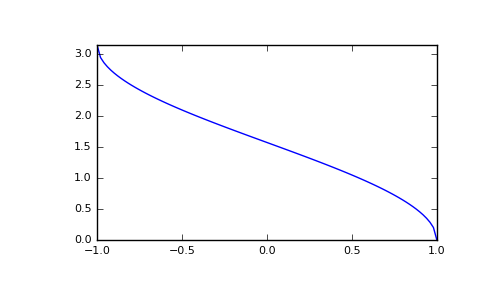-
numpy.arccos(x[, out]) = -
Trigonometric inverse cosine, element-wise.
The inverse of
cosso that, ify = cos(x), thenx = arccos(y).Parameters: x : array_like
x-coordinate on the unit circle. For real arguments, the domain is [-1, 1].out : ndarray, optional
Array of the same shape as
a, to store results in. Seedoc.ufuncs(Section ?Output arguments?) for more details.Returns: angle : ndarray
The angle of the ray intersecting the unit circle at the given
x-coordinate in radians [0, pi]. Ifxis a scalar then a scalar is returned, otherwise an array of the same shape asxis returned.Notes
arccosis a multivalued function: for eachxthere are infinitely many numberszsuch thatcos(z) = x. The convention is to return the anglezwhose real part lies in[0, pi].For real-valued input data types,
arccosalways returns real output. For each value that cannot be expressed as a real number or infinity, it yieldsnanand sets theinvalidfloating point error flag.For complex-valued input,
arccosis a complex analytic function that has branch cuts[-inf, -1]and[1, inf]and is continuous from above on the former and from below on the latter.The inverse
cosis also known asacosor cos^-1.References
M. Abramowitz and I.A. Stegun, ?Handbook of Mathematical Functions?, 10th printing, 1964, pp. 79. http://www.math.sfu.ca/~cbm/aands/
Examples
We expect the arccos of 1 to be 0, and of -1 to be pi:
>>> np.arccos([1, -1]) array([ 0. , 3.14159265])
Plot arccos:
>>> import matplotlib.pyplot as plt >>> x = np.linspace(-1, 1, num=100) >>> plt.plot(x, np.arccos(x)) >>> plt.axis('tight') >>> plt.show()(Source code, png, pdf)

numpy.arccos()
2025-01-10 15:47:30
Please login to continue.